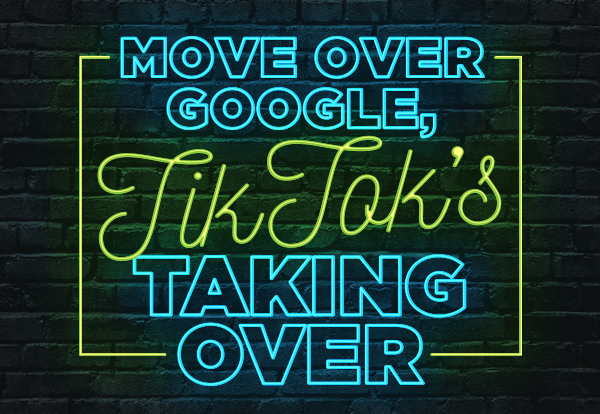For years, Google was the go-to method for finding answers to life’s most difficult and ridiculous questions.
Then TikTok happened.
I can still remember the first time I searched for something on TikTok instead of Google. It felt different. Real. Instant. And the best part? Everything came in video form. No scrolling through long articles or outdated blog posts; just quick, relatable, straight-to-the-point content. My Gen Z brain was here for it. Whether I’m looking for recipe inspo, health advice, celebrity drama, or breaking news, TikTok is now my first stop.
And I’m not the only one. In fact, nearly 51% of Gen Z already prefers TikTok over traditional search engines like Google.
So, what’s driving this shift in consumer behavior? And what does it mean for your food brand’s search & social strategy? Two great questions. Let’s dive in.
“Reliable” Sources
We tend to trust our peers more than professionals; it’s just human nature. A car mechanic might recommend getting your oil changed every 3,000 to 5,000 miles, but if your bestie insists that you can go 10,000 miles between changes without problem, you might be inclined to roll the dice despite expert advice. TikTok is like your peers on steroids. Instead of sifting through dry academic articles or product reviews, we’re watching real people share real experiences, and that feels more trustworthy. We live in an age of unlimited (and often contradictory) information. People can’t fact-check every claim that they stumble upon on social, but they can make a snap judgment on any creator that shows up on their feed. If you pass the vibe check, you’re in.
For brands, the concept of “Word of Mouth” marketing is nothing new. People have been influencing people since the dawn of… people. With TikTok, one person’s influence can have an outsized impact on consumer sentiment and behavior. Viral food trends like Dubai Chocolate, Chamoy Pickles, or Girl Dinner can turn into legitimate cultural moments, but there are thousands of instances of more under-the-radar content moving the needle within smaller communities. Seeing a friendly face show you a new air fryer recipe “hack,” or a relatable Mom breaking down why they prefer oat milk over almond milk, adds a layer of authenticity and is memorable in ways that words on a webpage can’t match. It gives users a human element to latch onto.
Accessibility
Searching on TikTok is just easier. You type in your question, and boom, dozens of creators are breaking it down for you in a minute or less. The more you engage with a topic, the more the algorithm feeds you similar content, and the top results are typically the most engaging and entertaining videos, creating an endless rabbit hole of information. This makes research feel less like research and more like scrolling. Search results become a part of your personalized content experience.
Here is where food brands should pay attention. Your product doesn’t necessarily need to be famous in order to be found. If a creator tags your brand in a trending recipe or compares it to a competitor in a top 5 snack taste test, TikTok’s algorithm can keep that video circulating for weeks, even without a huge budget behind it. In a world where visibility comes with a price tag, TikTok is your golden ticket to earn the same outcome organically.
Savvy brand managers are finding ways to make their product more accessible and algorithm-friendly all the time. Trendy content that highlights your product in a way that resonates with a specific online community, offering limited edition merchandise or packaging that speaks to a current cultural moment, and offering new, viral flavor profiles that creators can try are just a few tactics that make your brand feel more authentic and easier for users to interact with.
The Comment Section
In an age where conventional ratings and review sections are skewed by bots and bogus testimonials, TikTok’s secret power is its comment section. This is where the real discourse happens, where people call out misinformation, share additional tips, or just roast the creator. It may not always be 100% accurate, but it feels community-sourced and community-driven. It’s interactive in an authentic way that traditional search engines just can’t seem to recreate. For food brands, it’s an unfiltered focus group that reveals what consumers are actually thinking, saying, and sharing.
You’re not just seeing if people liked your product, you’re seeing how they used it, why it worked or didn’t work, and what weird things they are pairing it with. This is a cheat sheet for any brand trying to stay relevant, especially with the up-and-coming generation.
So what happens next?
TikTok will most likely continue to carve out a larger piece of the search pie, especially for younger audiences. If you’re a food brand wondering whether that matters to you, here’s a little exercise that can help bring some clarity to the TikTok question:
Fire up TikTok and head to the search bar. Type out your brand category or a problem that your brand solves. Keep it relatively generic, something like “high protein snacks” or “easy dinner ideas.” Take a good look at the results. Are people talking about your brand? Are they talking about your competitor? How many views, likes, comments, and shares are the top results getting? How many conversations is your brand being left out of?
TikTok is a place of discovery. It’s where food trends start, product reviews go viral, and recipes can get millions of views. Brands that lean into influencer partnerships and how-to content are already reaping the rewards.
TikTok may never fully replace Google, but it’s already changing the way we search, snack, shop, and share.
For savvy food brands and marketers, it’s changing the way we strategize.
Source: https://www.revelinteractive.com/blogposts/how-tiktok-became-gen-zs-favorite-search-engine#:~:text=Gen%20Z%20doesn’t%20Google%20it%E2%80%94they%20TikTok%20it.,over%20Google%20as%20their%20go%2Dto%20search%20engine.





